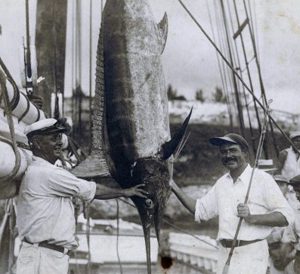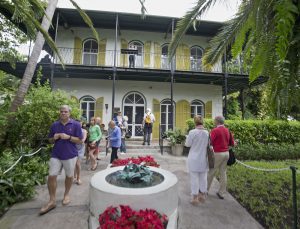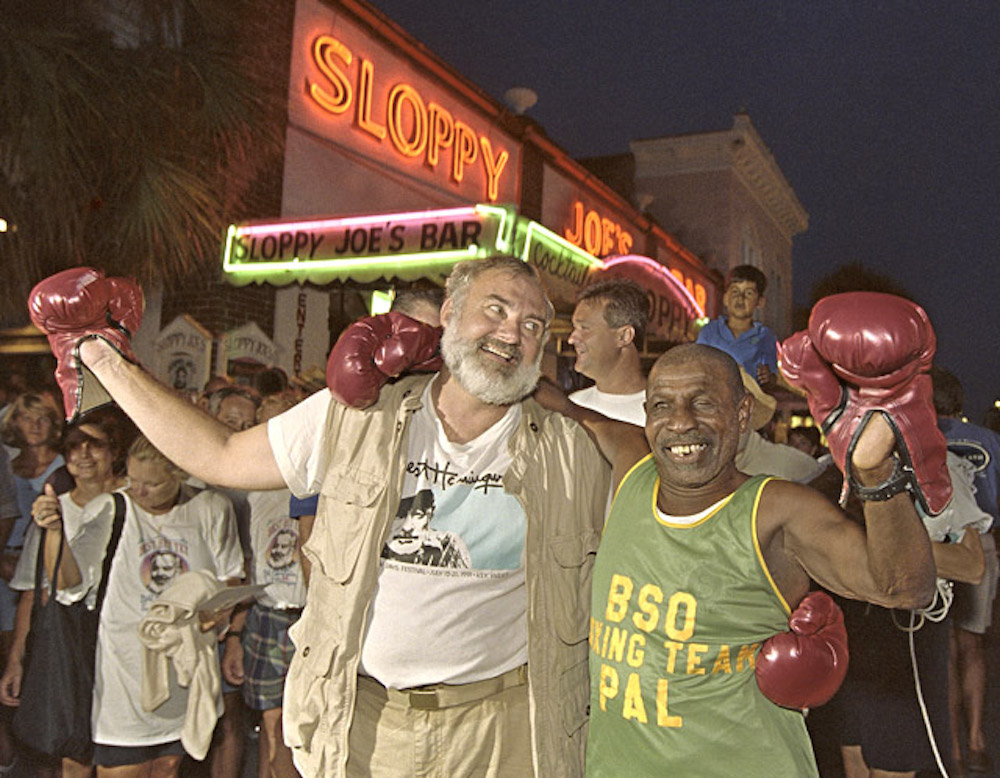While much of the world is on lockdown, and the Florida Keys remain temporarily closed to visitors, one way to connect with others is by sharing stories of cultural heritage and unique people. People, for instance, like “Shine” Forbes.

Ernest Hemingway (right) was a passionate angler during his Key West years. (Photo courtesy of the Key West Art & Historical Society)
When Ernest Hemingway lived in Key West in the 1930s, sparring and refereeing boxing matches were among his favorite pastimes. Until February 2000, the island was home to one of the last living links to the author: Kermit “Shine” Forbes, his one-time sparring partner.
Shine, as he was called by practically everyone who knew him, was a compact man whose body never lost the strength developed during his early physical training. Born in 1916, he was at one time an oyster harvester, a dishwasher and a fisherman. For many years, he was a cook at Key West’s Naval Hospital.
When he first met Ernest Hemingway, Shine was working with a fighter named Alfred “Black Pie” Colebrooks during a match at the Key West Arena, located in the Bahama Village neighborhood. Though the opposing fighter repeatedly drove Black Pie to the canvas, he rose and battled on — until Shine finally threw in the towel, signaling that they conceded the fight.
The referee, a shabbily-dressed man much bigger than Shine, threw the towel back. Shine threw it back in, only to have the referee throw it out again. After this happened a third time — and the towel hit Shine in the face — he jumped into the ring and took a punch at the ref, though it didn’t connect.

The Key West Arena, where Shine met Hemingway, stood on the property that’s now the funky and wonderful Blue Heaven restaurant. (Photo courtesy of Blue Heaven)
“I didn’t know who he was,” reported Shine during an interview in the late 1990s.
Later, his manager told him the man he’d tried to punch was the famous writer Ernest Hemingway.
“I went over to his house that night to apologize,” Shine said. “Hemingway shook my hand and asked me to come over the next day — and that’s when we began sparring.”
The young Shine, and his comrades among the local fighters, sparred regularly with Hemingway around the swimming pool at the author’s Whitehead Street home. According to Shine, Hemingway was considerate of his opponents during those rounds.
“He took it easy on us,” he recalled, “because he had the weight. He was a big man.”
One Christmas during a party at his house, the author had Shine and the other fighters put on a boxing exhibition. Among the guests was boxing great Gene Tunney. Hemingway passed the hat after the exhibition, and the Key West fighters ended up with a substantial Christmas “present.”

Visitors stroll on the entrance path of the Ernest Hemingway Home & Museum in Key West. Hemingway lived and wrote at the home for most of the 1930s, and sparred on the grounds with local fighters including Shine. (Photo by Rob O’Neal, Florida Keys News Bureau)
Until his death at age 84 in 2000, decades after he last sparred with Hemingway, Shine Forbes lived in a small Bahama Village home whose walls bore hundreds of photos and clippings about the author, his descendants, and Key West’s annual Hemingway Days. Shine often took part in the festival — and, on occasion, even put on the gloves and boxed with “Papa” Hemingway Look-Alike contenders.
He was also periodically sought out by journalists asking about his connection with Hemingway.
“I got kind of famous on account of him,” Shine said of the author. “If I never knew him, I would be just Shine around here.”
It would have been easy for Shine to exaggerate his friendship with Hemingway or his knowledge of the author. After all, few people could contradict any story he chose to tell. But he never did.
Instead, with the integrity Hemingway admired so many years ago, he stuck to what he knew: Ernest Hemingway the boxing aficionado, the man who didn’t put on airs but respected the skills of neighborhood fighters.
Maybe that’s one reason Shine, who never regarded himself as anyone special, is now an unforgettable part of Key West’s rich history — just like the “referee” who became his friend.

